Discover the captivating avian residents of Arizona as we delve into the diverse world of woodpeckers that call this southwestern state home.
With their distinctive plumage and rhythmic drumming echoing through the landscapes, these 11 woodpecker species contribute to the rich tapestry of Arizona’s ecosystems.
From the vibrant Gilded Flicker to the resilient Gila Woodpecker, each species has adapted to the unique challenges of the arid and varied environments.
Join us on a journey through the iconic saguaro-studded deserts, mountainous terrains, and lush woodlands to unveil these woodpeckers’ fascinating lives, behaviors, and ecological roles.
Arizona’s woodpeckers are not merely birds but integral components of the intricate web of life in this diverse and remarkable region. Stay focused.
Common Characteristics of Woodpeckers of Arizona
Woodpeckers, the rhythmic drummers of Arizona’s diverse landscapes, exhibit a set of common characteristics that enable them to thrive in this arid southwestern state.
These avian wonders play crucial roles in maintaining ecological balance while showcasing unique adaptations to the challenges of their environments. Let’s delve into the shared traits that define the woodpecker species of Arizona.
Distinctive Plumage
Woodpeckers boast striking black and white plumage, often adorned with flashes of red or yellow. This distinctive coloring adds to their aesthetic appeal and serves as a form of visual communication among these birds.
Specialized Bills
Equipped with sturdy, chisel-like bills, woodpeckers use these tools to excavate cavities in trees for nesting and feeding. The bills are also crucial for extracting insects from the bark and drilling into the wood to find hidden prey.
Rhythmic Drumming
Drumming is a hallmark behavior of woodpeckers, serving various purposes, including communication, territory marking, and locating insects.
Each species has its unique drumming pattern, contributing to the auditory richness of Arizona’s woodlands.
Adaptation to Arid Environments
Arizona’s woodpeckers have adapted to the challenges of the arid climate. Species like the Gila Woodpecker thrive in desert landscapes, displaying resilience in finding food sources such as cacti and insects.
Cavity-Nesting Behavior
Woodpeckers are expert cavity nesters, utilizing their strong bills to excavate holes in trees for shelter.
These cavities not only serve as nests but also provide essential homes for various bird species, contributing to the overall biodiversity of their habitats.
Versatile Diets
While insects form a significant part of their diet, Arizona’s woodpeckers showcase versatility in their feeding habits.
Some species, like the Acorn Woodpecker, supplement their diet with fruits and nuts, showcasing adaptability to the diverse food sources available in different habitats.
11 Woodpeckers of Arizona
Find out the diverse and fascinating woodpecker species inhabiting the southwestern United States and beyond.
Each species brings unique characteristics, from the iconic Gila Woodpecker thriving in arid deserts to the distinctive American Three-toed Woodpecker navigating coniferous forests.
Explore their vibrant plumage, distinct behaviors, and vital roles in maintaining ecological balance in this enlightening woodpecker journey.
1. Arizona Woodpecker
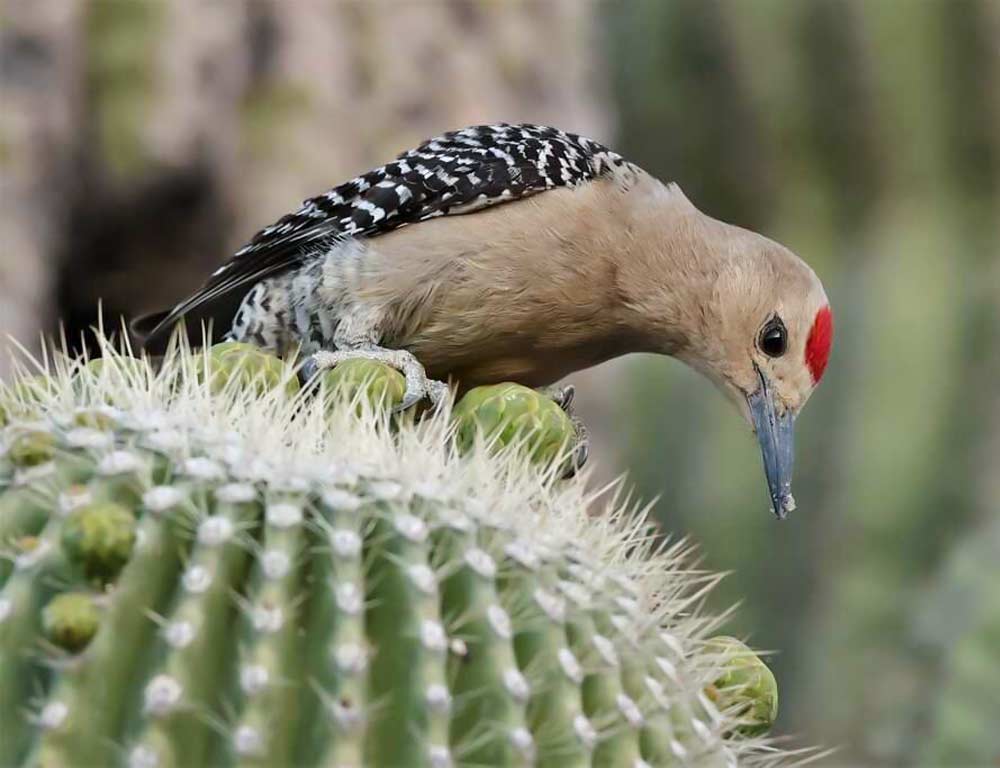
- Scientific Name: Melanerpes Arizona
- Population: Stable; specific numbers vary.
- Life Span: Up to 11 years.
- Size: Approximately 7-8 inches.
- Weight: Around 1.5 to 2 ounces.
- Wingspan: About 13-16 inches.
- Status: Least Concern.
The Arizona Woodpecker is a striking bird with a black and white barred pattern on its back and wings and a red crown on its head.
Found in the pine-oak woodlands of Arizona, these woodpeckers have adapted well to the region’s arid conditions. They primarily feed on insects, ants, and tree sap, using their strong bills to drill into the bark.
Arizona Woodpeckers are known for their drumming sounds, which are both a form of communication and a way to locate insects within trees.
They create cavities in trees for nesting and roosting, providing shelter for themselves and other cavity-nesting birds. They are generally monogamous and form long-term pair bonds, working together to raise their young.
2. Downy Woodpecker
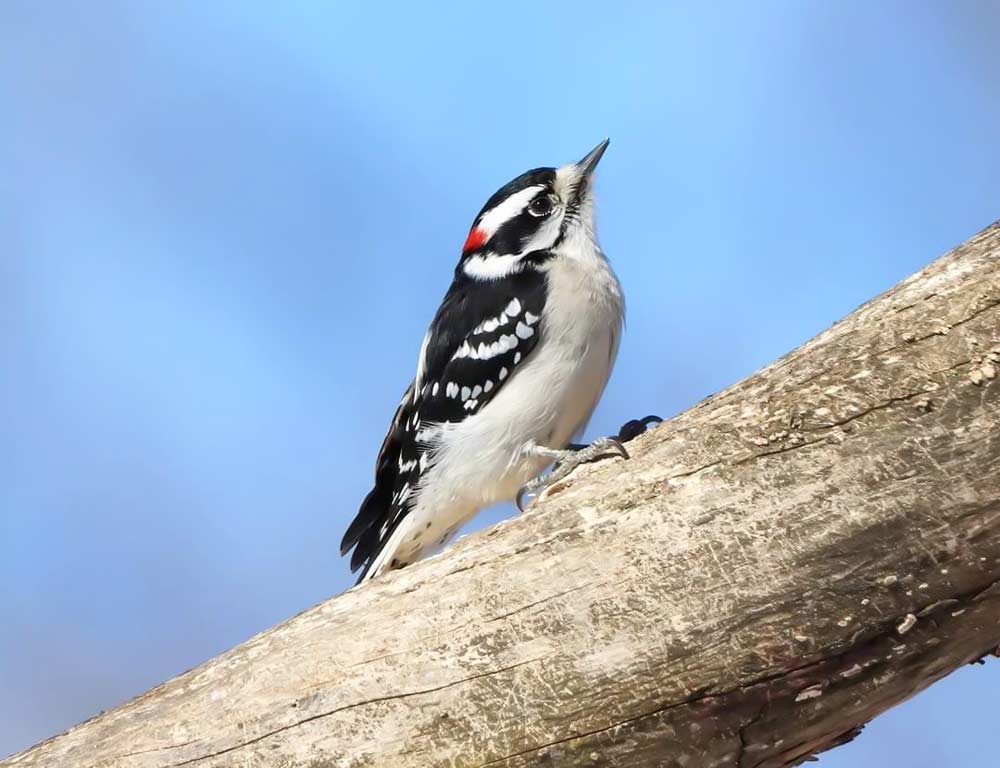
- Scientific Name: Picoides pubescens
- Population: Abundant and widespread.
- Life Span: 4-6 years.
- Size: 5.5-7 inches.
- Weight: Approximately 0.7-1 ounce.
- Wingspan: 9-12 inches.
- Status: Least Concern.
The Downy Woodpecker is the smallest woodpecker in North America. It has a distinctive black-and-white pattern, with males having a small red patch on the back of their heads.
They are commonly found in various habitats, including forests, parks, and gardens. Downy Woodpeckers are highly adaptable, foraging on various trees and shrubs for insects, seeds, and berries.
They are acrobatic climbers and use their short bills to extract insects from bark. Known for their drumming and tapping sounds, these woodpeckers communicate with each other through rhythmic beats.
3. Gila Woodpecker
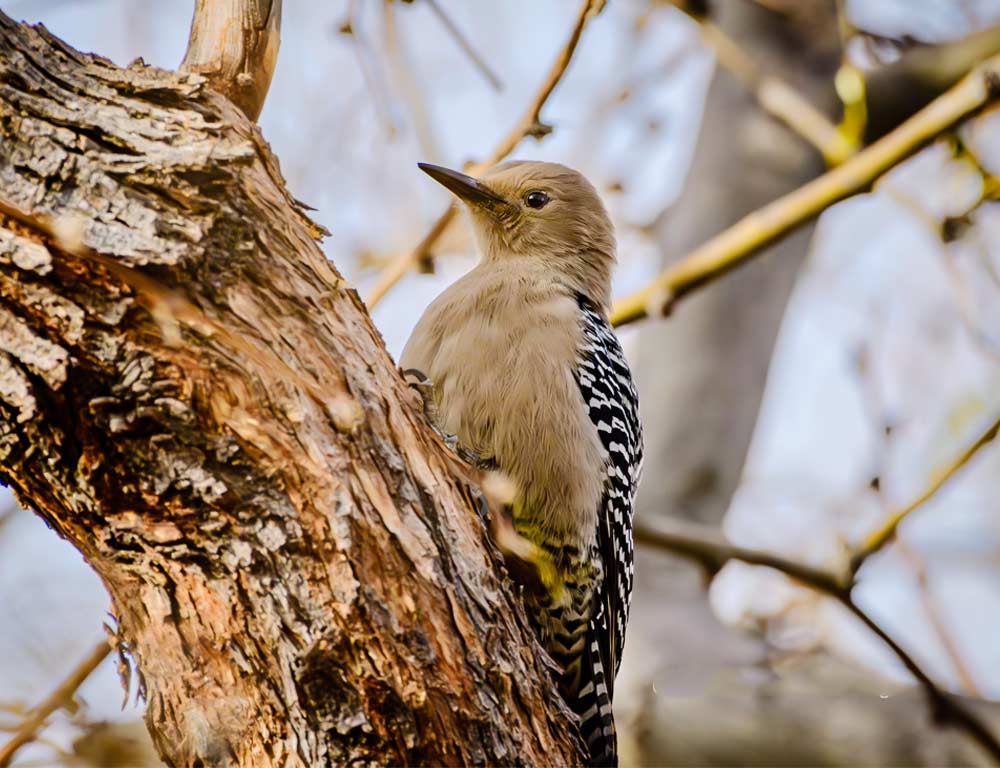
- Scientific Name: Melanerpes uropygialis
- Population: Common in the southwestern United States.
- Life Span: 7-10 years.
- Size: Approximately 8-10 inches.
- Weight: Around 2-3 ounces.
- Wingspan: 16-17 inches.
- Status: Least Concern.
The Gila Woodpecker is a medium-sized woodpecker with a distinct black-and-white pattern on its wings and back.
They have a red cap on the top of their heads and are often found in arid regions, including deserts and mesquite habitats.
Gila Woodpeckers have a diverse diet, feeding on insects, fruits, and nectar. They are known for their unique habit of nesting in cacti, using their strong bills to excavate holes for shelter.
These woodpeckers are well-adapted to the challenges of desert living, utilizing saguaro cacti as both a food source and nesting site. They play a crucial role in maintaining the ecological balance of their habitat by controlling insect populations.
4. Northern Flicker

- Scientific Name: Colaptes auratus
- Population: Common and widespread.
- Life Span: 6-8 years.
- Size: 11-14 inches.
- Weight: Approximately 3-5 ounces.
- Wingspan: 17-21 inches.
- Status: Least Concern.
The Northern Flicker is a medium to large woodpecker with a distinctive appearance.
They have a brownish plumage with black bars, a white rump, and a prominent black crescent on their chest. The undersides of their wings are bright yellow, visible during flight.
Northern Flickers are ground feeders, often foraging for ants, beetles, and other insects in open areas. They are also known to consume berries and seeds.
Unlike many woodpeckers, they frequently feed on the ground, using their slightly curved bills to extract prey. Their drumming sounds are characterized by a rapid and rhythmic tapping.
5. Acorn Woodpecker

- Scientific Name: Melanerpes formicivorus
- Population: Stable; population size varies regionally.
- Life Span: 9-15 years.
- Size: Approximately 8.5-9.5 inches.
- Weight: Around 3-6 ounces.
- Wingspan: 13-17 inches.
- Status: Least Concern.
Acorn Woodpeckers are known for their unique appearance, with a bold facial pattern and a prominent red cap on their heads.
Their back and wings are black, and they have a white underbelly. These woodpeckers are social and often seen in groups.
Acorn Woodpeckers are remarkable for their habit of storing acorns in granary trees, creating a centralized food storage system. They drill holes into trees to store acorns, and these storage trees are often used by multiple generations.
Their diet also includes insects, fruits, and sap. They are agile flyers and climbers, adept at navigating trees and performing acrobatic maneuvers.
6. Ladder-backed Woodpecker
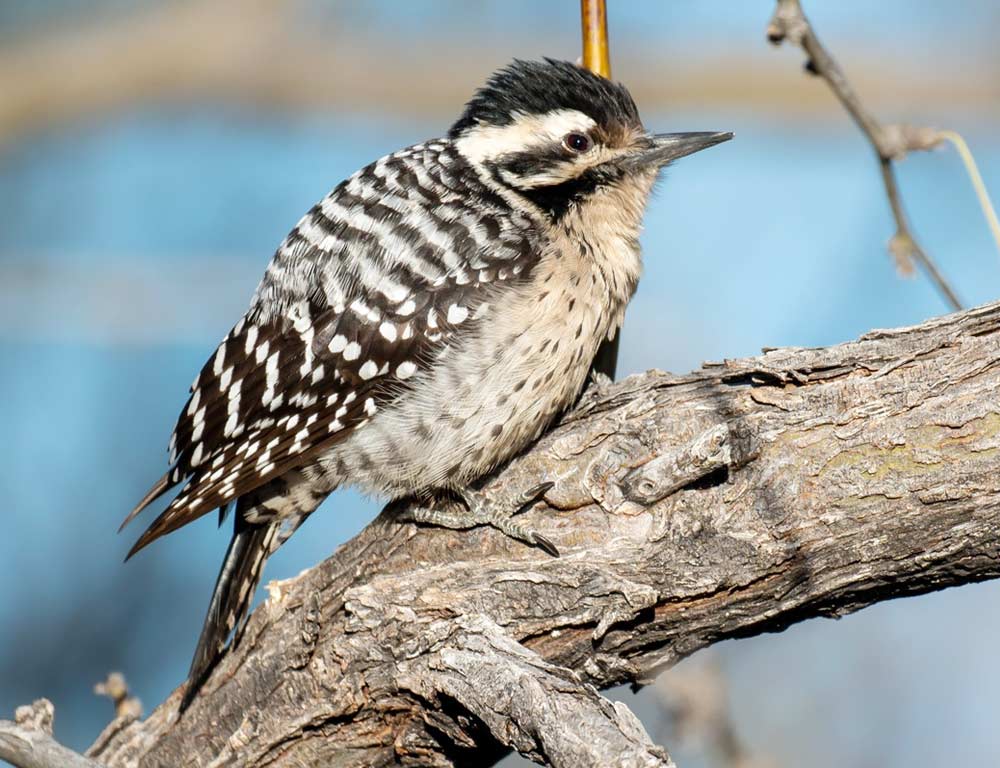
- Scientific Name: Dryobates scalaris
- Population: Stable; specific numbers vary.
- Life Span: 4-6 years.
- Size: Approximately 6-8 inches.
- Weight: Around 1-2 ounces.
- Wingspan: 12-14 inches.
- Status: Least Concern.
The Ladder-backed Woodpecker is a small woodpecker with a barred black and white pattern on its back and wings. Males have a red crown on their heads. They are commonly found in arid and semi-arid habitats.
Ladder-backed Woodpeckers primarily feed on insects, including ants, beetles, and caterpillars, by foraging on tree trunks and branches. They are adept climbers and can be seen exploring various vegetation for their prey.
These woodpeckers also drum and tap on trees for communication and territory marking. They are well adapted to living in desert environments, where they play a crucial role in insect control.
7. Red-naped Sapsucker
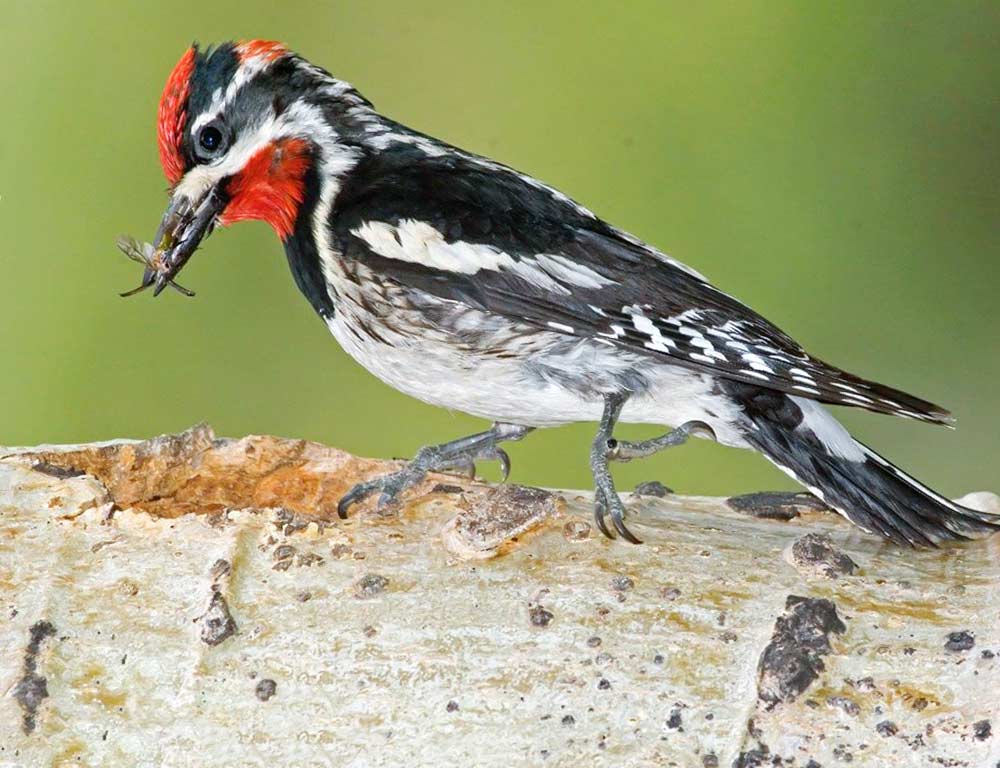
- Scientific Name: Sphyrapicus nuchalis
- Population: Generally stable; specific numbers vary.
- Life Span: 4-9 years.
- Size: Approximately 7.5-8.5 inches.
- Weight: Around 1.5-2 ounces.
- Wingspan: 14-16 inches.
- Status: Least Concern.
The Red-naped Sapsucker is a medium-sized woodpecker with a black and white pattern on its back and wings.
As the name suggests, it has a distinctive red patch on the nape of its neck, which is a key identifying feature. Males also have a red throat.
These sapsuckers are known for drilling sap wells in trees to feed on the sap, and the insects attracted to it. They create organized rows of sap wells, returning periodically to feed.
Red-naped Sapsuckers also consume insects, fruits, and tree sap. During the breeding season, they excavate cavities in trees for nesting.
8. Williamson’s Sapsucker
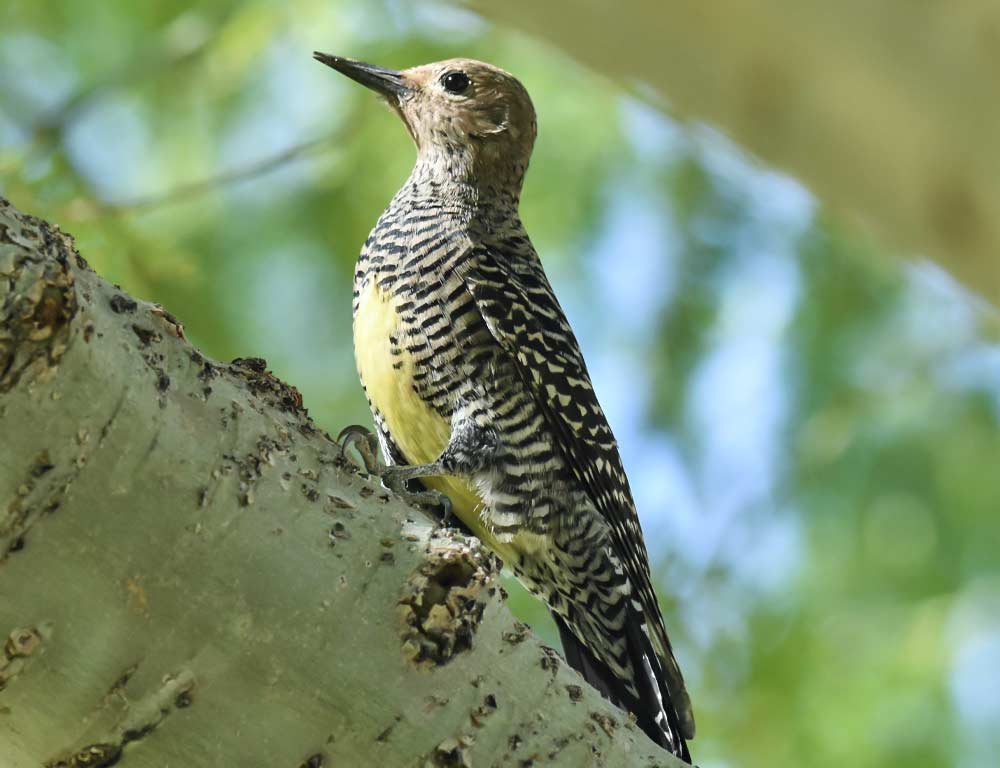
- Scientific Name: Sphyrapicus thyroideus
- Population: Generally stable; specific numbers vary.
- Life Span: 4-7 years.
- Size: Approximately 8-10 inches.
- Weight: Around 2-3 ounces.
- Wingspan: 16-18 inches.
- Status: Least Concern.
Williamson’s Sapsucker is a striking woodpecker with a black and white pattern on its back and wings.
Males have a black throat, red crown, and yellow belly, while females have a yellow throat and belly. They are often found in coniferous forests, especially in mountainous regions.
Like other sapsuckers, Williamson’s Sapsuckers feed on tree sap by drilling holes in the bark. They also consume insects, particularly during the breeding season when protein-rich food is essential for their young.
These woodpeckers are known for their strong flight and are skilled at catching insects on the wing.
9. Gilded Flicker

- Scientific Name: Colaptes chrysoides
- Population: Stable; specific numbers vary.
- Life Span: 4-7 years.
- Size: Approximately 11-12 inches.
- Weight: Around 3-5 ounces.
- Wingspan: 16-18 inches.
- Status: Least Concern.
The Gilded Flicker is a large woodpecker with a vibrant yellow or golden hue on its undersides and underwings.
It has a black crescent on its chest, and males have a red mustache mark on their faces. They are often found in arid habitats, including deserts and scrublands.
Gilded Flickers are versatile feeders, consuming insects, fruits, and seeds. They often forage on the ground for ants and beetles, supplementing their diet with fruits and berries.
These woodpeckers are known for their distinctive calls and are often observed drumming on trees during courtship and territorial displays. They nest in cavities excavated in saguaro cacti and other large trees.
10. American Three-toed Woodpecker
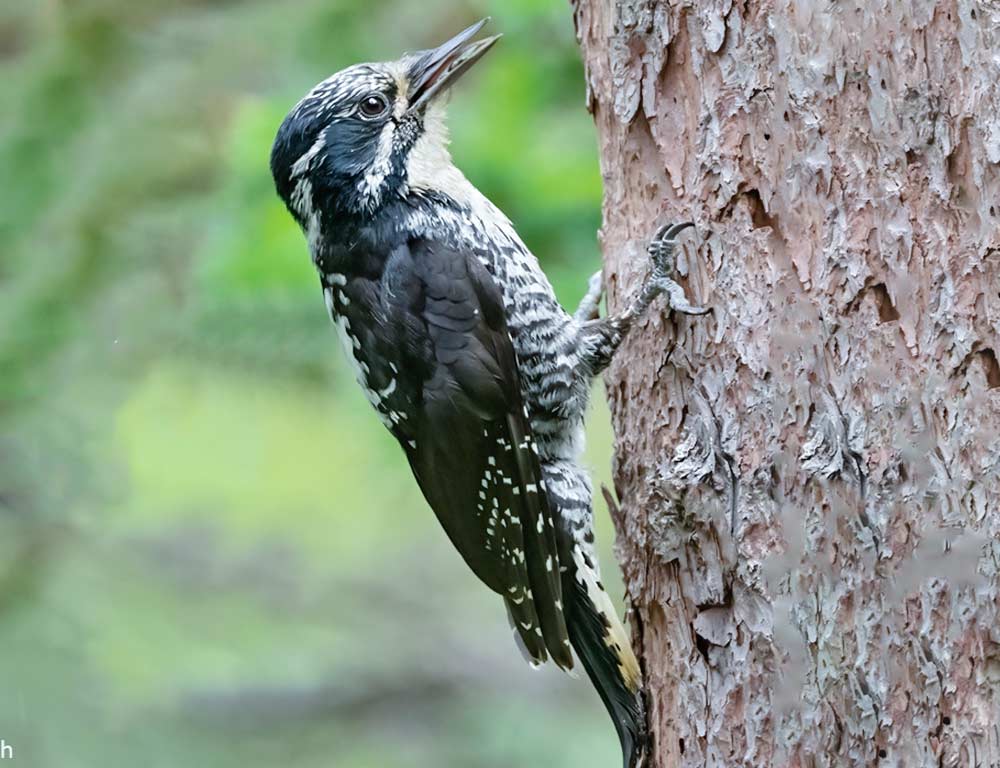
- Scientific Name: Picoides dorsalis
- Population: Generally stable; specific numbers vary.
- Life Span: 3-5 years.
- Size: Approximately 8.5-9.5 inches.
- Weight: Around 2-3 ounces.
- Wingspan: 16-18 inches.
- Status: Least Concern.
The American Three-toed Woodpecker is a medium-sized woodpecker with black and white plumage. Unlike other woodpeckers with four toes, it is named for having only three toes on each foot.
Males have a yellow crown on their heads. These woodpeckers are commonly found in coniferous forests, especially those affected by bark beetle infestations.
As their name suggests, American Three-toed Woodpeckers feed by scaling off the bark with their powerful bills to expose insects underneath.
They consume a variety of insects, including wood-boring beetles and their larvae. They also eat sap and forage in areas with dead or dying trees.
11. Strickland’s Woodpecker

- Scientific Name: Picoides stricklandi
- Population: Limited distribution; specific numbers not well-documented.
- Life Span: Limited information available.
- Size: Approximately 8-9 inches.
- Weight: Around 2-3 ounces.
- Wingspan: Information not well-documented.
- Status: Insufficient data for an IUCN Red List assessment.
Strickland’s Woodpecker, also known as the Hispaniolan Woodpecker, is native to the Caribbean, specifically the island of Hispaniola.
This species is characterized by its black and white plumage, with males typically having a red crown on their heads.
Information about Strickland’s Woodpecker’s lifestyle is limited, and research on this species is not as extensive as some other woodpecker species.
Like other woodpeckers, they likely forage for insects on trees, using their bills to drill into bark and extract prey.
Their specific diet, nesting habits, and social behavior may vary based on the unique ecological conditions of their Caribbean habitat. Conservation efforts for this species may be influenced by preserving suitable habitats on the island of Hispaniola.
Wrapping Up
The woodpeckers of Arizona showcase nature’s adaptability and diversity. From the rhythmic drumming of the Northern Flicker to the unique foraging habits of the Acorn Woodpecker, each species contributes to the rich tapestry of the region’s ecosystems.
These resilient birds play essential roles in pest control, seed dispersal, and habitat creation. As stewards of the environment, appreciating and protecting these woodpeckers ensures the preservation of Arizona’s unique biodiversity.
Their vibrant plumage and distinctive behaviors add a dynamic element to the natural landscapes they inhabit, making them a source of awe and inspiration for bird enthusiasts and nature lovers alike. Best of luck.